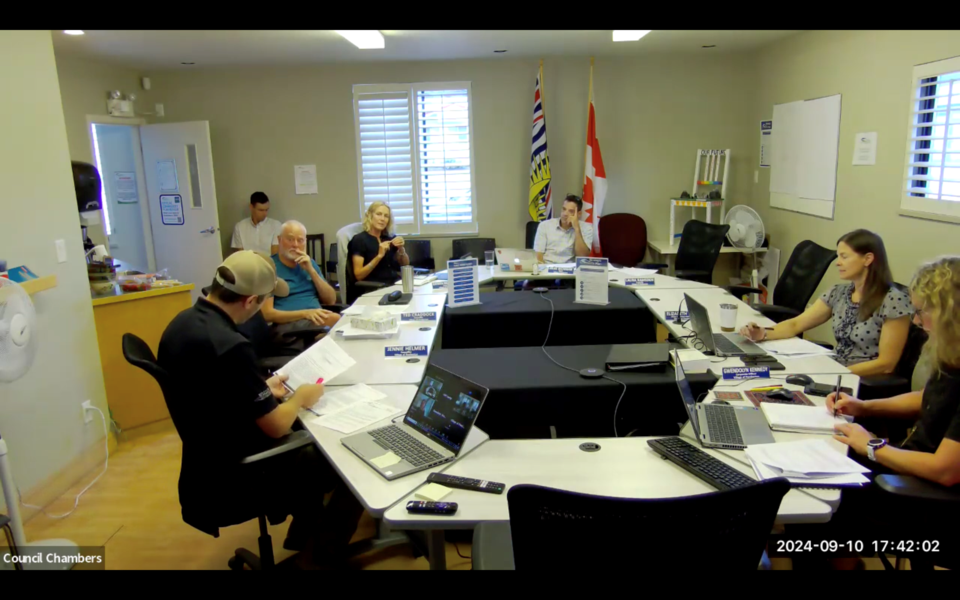Pemberton’s water consumption levels and quality from 2023 were on display at the Village of Pemberton’s (VOP) regular council meeting on Sept. 10.
The report, which covers water quality and water use, showed water consumption last year was slightly down compared with 2022, and there are lingering issues with manganese.
Pemberton’s water use
The average daily flow in 2023 was 2,052 cubic metres, about on par with the 2,055 cubic metres measured daily in 2022.
In total, the VOP consumed 748,115 cubic metres of water in 2023. Broken down by Pemberton’s 2021 population (3,407), that’s 219.58 cubic metres per year, per person.
High-use water days saw residents turning on the taps and using about 4,034 cubic metres, down from the year before. However, since the number of high-use days has gone up, water use averages evened out year over year.
“We'll start to see that number still go up as more properties get developed as well. But our water conservation efforts should be to bring down at least the high-day amounts,” said Tom Csima, manager of operations and projects, in presenting the report to council.
Other causes in variation aside from population growth, according to the report, include “climatic factors, conservation efforts and leak detection and repairs.”
Pemberton’s water quality
Water chemistry testing found results for Pemberton’s water quality were within Health Canada's Maximum Acceptable Concentration (MAC), but manganese is gradually increasing in wells two and three.
Manganese is naturally occurring and present in water from rock and soil weathering or mining, industrial discharges and landfill leaching, according to Health Canada’s guidelines. Some studies show neurological effects from manganese in drinking water for children, and Health Canada bases its MAC on infants due to the sensitivity of that population, but notes the limit is valuable for all Canadians. Health Canada’s MAC for the mineral is 120 µg/L.
The average of 11 sampling shows manganese levels for wells two and three are 88.4 µg/L and 47.5 µg/L, respectively, for 2023.
The village also uses Health Canada’s aesthetic objective (AO) of 0.02 mg/L (20 µg/L), as the mineral discolours water, which causes concern from consumers.
Well two exceeded both criteria levels once, and well three exceeded the AO once.
The short-term solution for reducing manganese in local water is well redevelopment. Redevelopment means flushing a well and cleaning the filter screen that gets caked with minerals, according to Csima. Well two was redeveloped this year, and well three is on the horizon for 2025.
Despite the redevelopment of well two, which did improve the well’s efficiency, it didn’t completely remove manganese.
“The quality did not improve as much as we had hoped,” Csima said. “We were hoping that might help with some of the manganese levels. They did come down, but we're not at zero … We’re keeping an eye and doing work on the treatment plant.”
In 2021, the VOP kicked off a preliminary study on its water-treatment system, and the report notes preliminary designs are coming in 2024 for a new water-treatment plant that can treat for manganese.
Other issues related to the local water supply include corrosive, low-pH water. Source water for Pemberton is naturally acidic, which can leach metals—like lead—from taps. The town adjusts pH levels to counter this, but it is still suggested by Vancouver Coastal Health to flush taps until water turns cold.
VCH has directed residents since 2015 to flush their pipes to prevent lead leaching into their drinking supply from pipes in homes, and Pique has documented the stories of concerned residents over the years.
The province requires municipalities to publish annual drinking water reports through the Action Plan for Safe Drinking Water in British Columbia (2002). The report is publicly available and submitted to VCH.
A video recording of the meeting is available on YouTube.




